The initial engine choice was the brand
new 999cc FIRE engine (45bhp), the Brazilian made 1049cc Fiat 4 cylinder
(55bhp) or the same 1049cc engine but fitted with a turbocharger
and intercooler (85bhp). The latter was the smallest turbo car on the market in Europe.
The only body available was the standard
three door - an interesting feature of which was the tailgate which was
matt black on every car made ! A drag coefficient of 0.31 was good for
the class. In order to wear the 'luxury' tag, there were numerous standard
and optional items, such as climate control, electric (outward) opening
rear windows, heated rear window, electric windows and central locking.
At the Turin motorshow in 1986 the Y10
4WD was shown. This had a swichable four
wheel drive system using an electro-pneumatic control system and used
the 999cc FIRE engine modified to produce 50bhp.
In 1989 the complete range was revised.
The main changes were the addition of an 1108cc single-point fuel injected
FIRE engine 1992 saw the introduction of the third
series. The interior was heavily revised, with a completely new dashboard,
instrumentation and trim and numerous other changes. The 999cc FIRE engine
was dropped from the range and a new gearbox was introduced for the 1108cc
engine. The body gained new rear light clusters, new door mirrors, new
(wider) wheels and tyres, new grille and a relocated rear registration
plate. More optional extras became available including headlamp wash/wipe,
air conditioning and adjustable headlamps (from inside).
Over the years the Y10 was also sold in many
limited editions, mainly differing in internal trim and body colour options.
Some of the more popular of these were the 'Fila', 'Missoni' and 'Martini'
in the first series, the 'Mia' and 'Avenue' in the second series and the
'Elite' in the third series.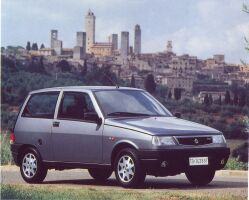 Designed in house at the FIAT Design Centre as a 'compact' or 'city' car and released
in 1985 at the Geneva Motorshow, the Y10 was the first car to use the new
FIRE (Fully Integrated Robotised Engine) engine. It was priced above the
conventional opposition, Lancia justifying this by defining it as a 'luxury
runabout'. Front suspension was taken from the Fiat Panda,
whilst the rear had a new unique-to-Lancia 'Omega' system.
Designed in house at the FIAT Design Centre as a 'compact' or 'city' car and released
in 1985 at the Geneva Motorshow, the Y10 was the first car to use the new
FIRE (Fully Integrated Robotised Engine) engine. It was priced above the
conventional opposition, Lancia justifying this by defining it as a 'luxury
runabout'. Front suspension was taken from the Fiat Panda,
whilst the rear had a new unique-to-Lancia 'Omega' system.
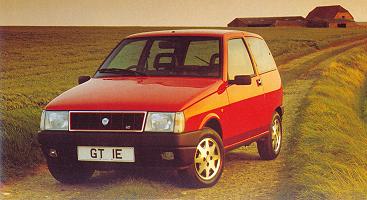 (57bhp),
a new multi-point fuel injected 1300 sohc engine in the new GTie (78bhp)(which
replaced the turbo) and the introduction of a new CVT (Continuously Variable
Transmission). The rear suspension and front brakes were also modified.
(57bhp),
a new multi-point fuel injected 1300 sohc engine in the new GTie (78bhp)(which
replaced the turbo) and the introduction of a new CVT (Continuously Variable
Transmission). The rear suspension and front brakes were also modified.
Numerous details were also changed - fabrics
(Alacantra throughout the GTie), steering wheel adjustment, the climate
control system and the front grille. 1989 also saw the Y10 Elettrica appear.
Technical Details
| Driveline | transverse engine at front with front wheel drive |
| Engines | 999cc (70x64.9mm) sohc 4 cyl with 45bhp @ 5,000rpm (50bhp in 4WD)
1049cc (76x57.8mm) sohc 4 cyl with 55bhp @ 5,850rpm 1049cc (76x57.8mm) sohc turbocharged 4 cyl with 85bhp @ 5,750rpm |
| Suspension | front : MacPherson strut with telescopic dampers and coil springs plus anti-roll bar
rear : 'Omega' type - centrally hinged with coil springs and telescopic dampers. wheelbase : 2159mm (4WD : 2178mm) front track : 1281mm (4WD : 1268mm) rear track : 1277mm (4WD : 1278mm) |
| Brakes | front : discs, diameter 227mm or 240mm
rear : drums, diameter 185mm handbrake operating on the rear via cable dual hydraulic circuit with servo assistance |
| Gearbox | 5 speed manual
CVT clutch disc diameter : 181mm |
| Steering | Rack and pinion |
| Kerb weight | Early cars from 720kg (FIRE), 790kg (turbo) to 850kg (4WD)
1.1ie : 800kg Selectronic : 815kg 1.3 Elite : 855kg 4WD : 890kg |
| Dimensions | click here. |
Performance
| model | max speed | 0-100kp/h | standing km |
| 1.1ie | 150 km/h | 15.8 sec | 37 sec |
| Selectronic | 145 km/h | 18.1 sec | 38 sec |
| 1.3 Elite | 170 km/h | 12.5 sec | 34.5 sec |
| 4WD | 142 km/h | 18.9 sec | 39.5 sec |
Tuning
The Y10 has a major advantage over other cars when it comes to tuning, and that is it's light weight. When coupled with the turbo engine there is a lot of potential to make a car which will enable cross country journeys to be undertaken very rapidly (and with the ususal Italian car fun) and also embarass much more expensive equipment.
There are three main areas to concentrate on, the engine (and transmission), the brakes and the suspension and then various other details. These three should be done together since they complement each other, not all of one and none of another !
1. The engine.
The first improvements are relatively simple.
The air filter can be replaced for an aftermarket item which will help
the engine breathe more freely, the type which completely replace the original
airbox are best, and the exhaust can be replaced for one which will restrict
the exit of the gases less. The whole system should be replaced, not just
the rear section.
On those cars with electronic injection
and ignition, probably the most effective modification (short of engine
rebuilds!) is to replace the electronic control unit (or 'chip'). For the
Y10 availability of off-the-shelf units is poor, and so useage of a unit
designed for any engine is probably required which will mean some programming
and useage of a rolling road.....
On other cars (and also a possibility on
electronically controlled cars) the best option is to fit larger carburettors
- preferably two twin units, giving one venturi per cylinder. A camshaft
change will also significantly improve the power and torque, but attention
must be paid to the characteristics since some camshafts, usually those
with the best absolute figures, are not very driveable except on a race
circuit.
On the Y10 turbo's the job of increasing
the power is even easier, fitting a bleed valve will result in significant
gains, but do not be tempted to raise the boost pressure too far or the
fuelling will not be able to cope and the engine will run weak. Water spray
on the intercooler is also worth considering, switched by either an air
temperature sensor (the ideal solution) or bay a MAP sensor (the easy solution).
Consider also adding an octane boosting product to the fuel on cars with
increased boost levels, it will help the ignition cope.
Other things to do should include fitting
a cold air intake, a large diameter pipe (minimum 5cm) to provide air from
outside the engine bay to the air filter. The exhaust manifold can also
be lagged with thermal cloth or tape to keep the exhaust gases hotter (and
thus reduce back pressure) and also to keep the underbonnet (and hence
intake and fuel) temperatures lower.
Further modifications require the machining
of the cylinder headand/or cylinder block (which will not be dealt with
here since it is not normally a DIY job) after which it may be worth fitting
Regarding the transmission the main requirement
is to uprate the clutch to handle the increase in power and torque achieved
though the engine modifications. Friction plates can be purchased with
improved materials and heavier duty pressure plates are also available.
Whilst doing this it is worthwhile lightening the flywheel.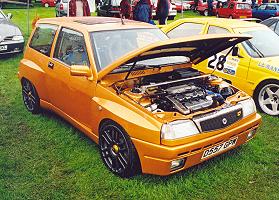 Before modifying the engine it is worthwhile
filling it with a good quality synthetic oil and fitting new spark plugs.
An engine oil additive may also be used.
Before modifying the engine it is worthwhile
filling it with a good quality synthetic oil and fitting new spark plugs.
An engine oil additive may also be used.
The high tension leads can also be replaced
with performance ones.
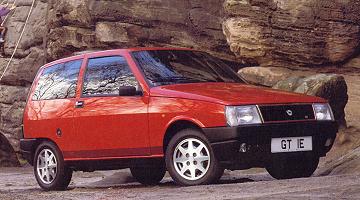 an oil cooler. If overheating is a problem due to the increased power output
then a small hole can also be drilled through the plate in the thermostat.
an oil cooler. If overheating is a problem due to the increased power output
then a small hole can also be drilled through the plate in the thermostat.
2. The brakes.
Initially it is relatively easy to replace the brake discs with drilled and grooved items, and the pads for a harder compound. The latter should not be too hard (ie no race pads on the road) or they will not function effectively at the normal 'road' operating temperatures. Stainless steel braided flexible hoses will improve the pedal feel and reduce the chance of damage whilst DoT5 fluid (not silicon) will increase the temperature at which it can operate effectively. If the brakes are getting too hot the dustguards can be removed and/or ducts fitted, taking air from behind the front bumper.
If more serious braking is required the
next modification would be to increase the disc size. It is possible to
use larger discs with a bracket allowing use of the production callipers,
or alloy four pot callipers can be fitted. Lesser models can of course
use the components from the more potent family memebers.
In order to improve the balance of the
car under braking it is desireable to be able to adjust the balance of
braking from front to rear (and vice versa). This can be accomplished by
fitting a bias valve in the line to the rear brakes, usually in a position
so that it can be reached from the drivers seat.
3. The suspension.
The easiest improvement,and the one which
will probably bring the single most noticeable change, is to replace the
dampers and springs. Fitting lowered springs will improve the cornering,
but must be fitted together with shortened throw dampers, or else the springs
may unseat ! Top adjustable dampers are compromised, but are good for road
and track day cars since it allows the suspension to be adjusted between
these two, rather different, requirements. Coil over units add more adjustability
and can be purchased outright, or can be made from standard dampers by
welding a threaded sleeve to the standard tube.
There are then two other main suspension
aims; to reduce the flexiblity in the suspension and to increase the stiffness
Into this category also fall the choice
of wheels and tyres. With an increase in power it can be necessary to fit
larger tyres (thus requiring larger wheels) but the temptation to fit the
biggest possible should be resisted. Consideration should be given to fitting
a wider tyre on the front (since they provide traction and steering) but
keeping the standard, or a wider but not as wide as the front, tyre at
the rear. This will improve the balance of the car.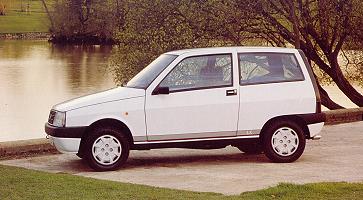 of the car, both of which aim at more accurate control of the wheel movement.
To reduce the flexibility it is possible to fit nylon bushes instead of
the normal production rubber items, or if perfection is desired the suspension
can be fitted with metallic bearings (rose joints / rod ends). Spherical
bearing top mounts can also be used. To stiffen the car it is most popular
to fit strut braces. These can be fitted to the front and rear. For more
extreme cases a rollcage can be fitted.....
of the car, both of which aim at more accurate control of the wheel movement.
To reduce the flexibility it is possible to fit nylon bushes instead of
the normal production rubber items, or if perfection is desired the suspension
can be fitted with metallic bearings (rose joints / rod ends). Spherical
bearing top mounts can also be used. To stiffen the car it is most popular
to fit strut braces. These can be fitted to the front and rear. For more
extreme cases a rollcage can be fitted.....
4. other things.
Other modifications worth considering include fitment of a shift light (and rev limiter if there is not one as standard), higher power bulbs in the headlights (if you are going to go faster you need to see further) and installation of a quicker steering rack. It has been known for a complete Integrale engine and four-wheel-drive drivetrain to be installed as well as the Uno turbo engine and other more radical versions. As with most such cars, there are a lot of possibilities given the common parts bin.
For books on Lancia see our Online Bookstore
There is also a list of all our picture galleries (including museums, motorshows and various events).
Wallpapers/Desktop Backgrounds of numerous Lancia's, including the Y10, are available to download.
See also our Lancia advertisements gallery, where several old adverts can be seen.
Buying / Selling
Some tips to do before selling :
(they may seem obvious, but most people don't do them and thus are in a
weaker bargaining position)
Tidy inside the car thoroughly : hoover
the floor, empty all pockets, ashtrays (wash), glove compartment etc...,
wipe the trim with a damp cloth, give the cockpit a good airing to get
rid of any odours ! Reset the trip meter to 00000 - it is a pleasant (subconcious) surprise.
If the car has been standing give it a
good run - this will clear out the engine (reduce exhaust smoke), put a
shine on the brake discs and loosen up any joints that may otherwise make some noises.
'Back to black' products are very effective
at temporarily restoring bumpers and trim. This makes a big difference
to any car. Do it a week before you expect people to view the car, otherwise
it may be a bit too obvious !
Jetwash under the car, especially under
the engine and in the wheelarches. The prospective buyer may be an enthusiast,
and this makes it easier for them to see what they want to check.
Obviously wash the car and clean the windows !
If you are going to buy a car always
check the following :
Especially neccessary on older Y10's is
to check the bodywork. Pay special attention to the wheelarches (inside
if there is no plastic splash guard), suspension and engine mounts, sill,
door pillars (check for sagging doors), scuttle panel and the floor (doors,
bonnet and boot/hatch are also susceptible, but are more easily replaced).
If a sunroof is fitted check around the edge for signs of rust. Also check
around the fuel tank, the tank itself is plastic, but the mountings sometimes
rust, leaving your fuel tank on the road...
Check that there are no mismatching panels,
large areas of discolouration or signs of fresh paint.
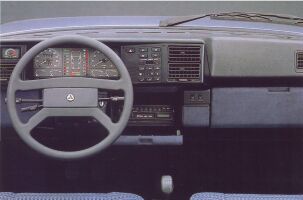 Check
for a damp carpet or the presence of mould - if the carpet is damp then
the floor is almost certainly corroded. Check the rest of the internal
trim, especially the seats, for thinning or fraying, the materials were not so robust.
Check
for a damp carpet or the presence of mould - if the carpet is damp then
the floor is almost certainly corroded. Check the rest of the internal
trim, especially the seats, for thinning or fraying, the materials were not so robust.
Check the main electrical functions - wipers,
windows,lights etc... try putting the main beam and wipers on at the same
time. Check the headlight reflectors for rust. A random display of warning
lights does not necessarily mean there they are trying to indicate something,
on the Y10 they seem to often illuminate for no reason.
Check the brake pedal does not go to the
floor if pressed hard for a long time and check the gearchange for clean engagement.
The engine should be run up to temperature,
check the exhaust for smoke (especially on turbocharged models), the condition
of the breather (look for mayonnaise), the condition of the oil filler cap
(again white deposits can indicate head gasket or other serious problems)
and the colour of the coolant (preferably not brown!). If it has an oil
pressure guage this should not drop below 1 bar at idle, and should be
around 3 to 4 bar at speed. Listen to the noise of the engine, then depress
the clutch and engage first gear. Whatever noise has disappeared was coming
form the gearbox, what remains is from the engine. Check the colour of
the oil using the dipstick. A golden-brown is best, darker brown is ok,
but thick and black should be avoided.
Check tyre wear, uneven patterns could imply a bent chassis.
Always take it for a test drive. Check
that the car tracks in a straight line with no steering input. Find a large
open area and complete several lock to lock turns (also in reverse), listening
for any noises. Try the handbrake when moving - seized rear callipers will
mean uneven braking or no braking.
Links
An informative Y10 site.
Y10 comment form
Your Comments
I've just parted from the
love of my life. I got her brand new in 1988. Added an airconditioner and
wouldn't have swapped her for a rolls.Body very prone to rust. Lousy cornering
stability. Can go where jeeps fear to enter, but I no longer can. My suspension
is worn out so we had to part.Grandma.
I am about to part with my
first car a 1989 Lancia Y10 FIRE, I've owned other cars but always ended
up in this again, I will never forget it, even if I did have some hairy
moments with the lousy handling. It was sound off road too, its been rallyed
a few times! I want another but there so scarce. (Andrew)
i am from greece and i loved the y10 and the lancia.y10 is my first car and i hope to take the new model(elefantino)y10
is my first car,my first love,y10is smart y10is nice y10its my life,my wife,its my family...y 10 of lancia is my memorys,its my car.thanks lancia ! d j john
The Lancia Y10 is the perfect car for people living in (big) cities with lots of traffic, which doesn't mean that you can travel with it on longer distances.
My one is reliable and came with a lot of extras.
I owned a 1988 Y10 fire lx for 3.5 years. It was always reliable, had no rust and never broke down. There were no rattles or squeaks, in cold weather it took 5 times
to start, in normal weather 3 times but it never failed, its fuel economy was superb. I regret selling it because even the Cinq cannot match its overall qualities for economy driving, parking was so easy.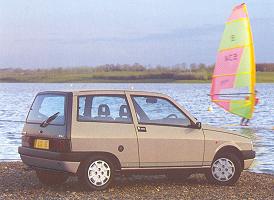 Bought my Y10 new in january
'86, my first ever new car! I parted with it,reluctantly, 2 years later
because it was too small to fit my boat on top.I've had four other Italian
cars since and now drive a Jaguar but I still remember my old White Hen
fondly.(BOB)
Bought my Y10 new in january
'86, my first ever new car! I parted with it,reluctantly, 2 years later
because it was too small to fit my boat on top.I've had four other Italian
cars since and now drive a Jaguar but I still remember my old White Hen
fondly.(BOB)
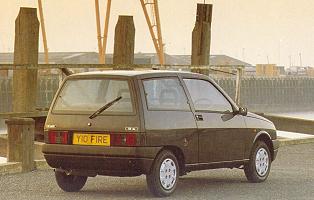 Use the buttons at the top to navigate
further, or
Use the buttons at the top to navigate
further, or
Copyright © 2000 to 2008 CarsfromItaly